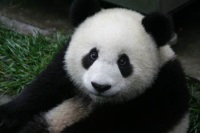Giant Panda -- School-age
Hibernate
The giant panda does not hibernate during the winter. Due to their leaner diets, they do not build up the excess fat needed to hibernate. They also live in a habitat zone where food is available all year round.

The giant panda does not hibernate during the winter. Due to their leaner diets, they do not build up the excess fat needed to hibernate. They also live in a habitat zone where food is available all year round.

Its diet is made up almost entirely of the leaves, stems and shoots of various bamboo species. Since bamboo has very little nutritional value, pandas must eat large amounts of it to provide them with the nourishment they need. A giant panda will eat 26-84 lbs (12-38 kg) of bamboo every day to meet its energy needs.
While bamboo represents 99% of their diet they have also been known to eat fish, pikas, rodents, vines, irises, crocus, mushrooms and rice grass. Pandas are classified as carnivores because they have the same digestive system as other carnivores but they rarely eat meat.
The panda assumes a sitting position to eat. Their unique forepaws have an enlarged wristbone that they can flex like a thumb. This allows them to direct bamboo stalks to their mouths where they strip off bites with their incisor teeth. About 12 hours each day are spent feeding and they consume 12-15% of their body weight each day. They drink water usually just once a day.
Giant panda bears have a massive head, heavy body, short tail, rounded ears and plantigrade feet (both heel and toe make contact with the ground when walking in a manner similar to humans).
They walk through the bamboo forest with a rolling gait. Unlike many other bears, pandas do not walk on their hind legs and only climb trees when threatened. Pandas area generally solitary animals, even avoiding contact with others of its kind.
Giant pandas have very good eyesight. Most bears have round pupils. The giant pandas pupils are vertical slits like cat's eyes. The Chinese people call the panda "Da Xiong Mao," which means "giant bear cat" in Chinese.

The Panda is a large mammal about 5-6 feet high. They will weigh up to 350 pounds with the males weighing about 10% more than females. The ears, eye patches, legs and shoulder band are black while the rest of the body is white.
This black-and-white coloring may camouflage the panda in the snowy environment. The fur of the giant panda is thick and coarse. It consists of a coarse outer layer and a very dense, wooly-like underfur. To the touch, the fur feels oily and this oily substance protects and insulates the panda from the cool and damp climate it lives in.
Female pandas are called sows, males are called boars, and the young are called cubs. Female giant pandas mature at about 5 to 7 years of age. Mating begins in the spring with the panda bears attracting each other with calls and odors. Mature female giant pandas in the wild usually breed just once every two or three years and typically have about five litters in their lifetime.
When cubs are born they are blind and pink in colour with little white hair. Their coat begins to darken about a month after their birth. The cub when born is as big as a common mouse at about 28 inches long and weighing about 6 ounces (85-100gm)
Panda cubs cry when they are hungry. They start eating bamboo when they are about 6 months old and are fully weaned from their mother at about 9 months. At one year of age, the cubs normally weigh about 75 pounds. Panda cubs stay with their mother for one to two years. They are fully grown in 2-4 years.
The giant panda is a black and white bear that is on the verge of extinction. There may be only a little more than 1000 pandas remaining in very fragmented and isolated areas. Giant pandas live only in the mountain ranges in the provinces of Sichuan, Shaanxi, and Gansu in Western China.

The panda is a symbol of peace in China. Humans are the giant pandas only enemy. The Chinese government has taken steps to protect these endangered animals.
Panda Triangle Diorama
Fold a 9" by 9" construction paper or poster board. Fold the paper-top left corner to bottom right corner open, then fold top right corner to bottom left corner.
Open and cut from the bottom right corner to the center.

In the area 1 and 2 draw a bamboo forest.

Overlap and staple the two cut bottom triangles. Stand the triangle diorama up. Add pandas made from clay, playdough, or paper.

Mrs. Harkness and the Panda
by Alicia Potter
Knopf Books for Young Readers
Pandas! An interesting story of how the first panda came to the United States. The time is set in the late 1930's when an astonishing woman, Ruth McCombs Harkness, heads off on an expedition to find a baby panda bear. The story illustrations by Melissa Sweet are bright and colorful. The story is brief but just right for the intended audience-young elementary children.
DIY Panda Mini Notebook from one sheet of paper.